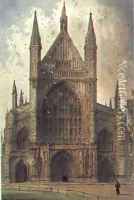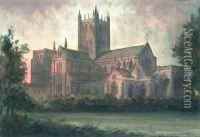Paul (J.L.Crees) Braddon Paintings
Paul Braddon, born Joseph Lisle C. Crees in 1864 in England, embarked on a journey that would see him leave an indelible mark on the art world under the pseudonym Paul Braddon. His life, spanning from the late Victorian era into the early 20th century, was a testament to his adaptability and skill as an artist, navigating through the changing tides of artistic tastes and emerging technologies.
Braddon's early years were marked by a conventional education, but it was his passion for art that truly defined his path. He demonstrated a keen interest in the burgeoning field of illustration, a medium that was gaining tremendous popularity thanks to advances in printing technology and the growing appetite for illustrated books and periodicals. By the late 1880s, Braddon had established himself as a talented illustrator, contributing to various publications and earning recognition for his detailed and evocative works.
Seeking broader horizons, Braddon moved to Australia in the late 19th century, a decision that would significantly influence his artistic output. Australia's vibrant landscapes, unique flora and fauna, and burgeoning cities offered new inspiration for Braddon. During this period, he produced a prolific amount of work, ranging from landscapes and cityscapes to illustrations that captured the essence of Australian life. His work not only appealed to the aesthetic sensibilities of his contemporaries but also served as valuable documentation of an evolving Australia.
Despite his success, Braddon remained a somewhat enigmatic figure in the art world. He often shied away from the limelight, preferring to let his work speak for itself. This discretion, combined with his use of a pseudonym, has led to challenges in fully appreciating the scope of his contributions to art and illustration. Nevertheless, Braddon's work continues to be studied and admired for its technical skill, attention to detail, and ability to capture the spirit of an era.
Paul Braddon's death in 1937 marked the end of a career that had spanned over five decades. Throughout his life, he witnessed and contributed to significant transformations in the art world, from the golden age of illustration to the early modernist movements of the 20th century. His legacy, a rich collection of works that celebrate both the natural beauty and the human experience, remains a valuable asset to the understanding of this transformative period in art history.


